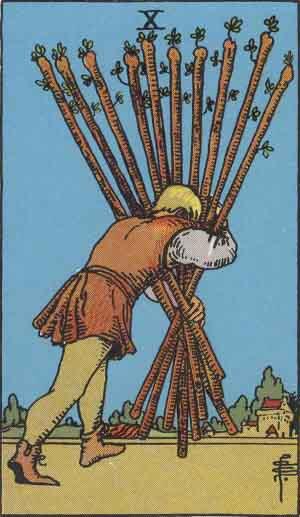The Ten of Wands is a card in the Tarot deck that often raises questions about its implications in providing a simple ‘yes’ or ‘no’ answer. In the intricate world of Tarot, where symbols and interpretations intertwine, the notion of a direct ‘yes’ or ‘no’ in response to this card can be elusive. Understanding its nuances in both upright and reversed positions sheds light on its complex meanings.

When drawn upright, the Ten of Wands signifies a burden, overwhelming responsibilities, or the feeling of being weighed down by obligations. Its imagery typically depicts a figure carrying a heavy load of wands, suggesting an individual overwhelmed by tasks, commitments, or challenges. In this context, the card doesn’t provide a straightforward ‘yes’ or ‘no’ response but rather encourages a deeper exploration of the situation at hand.
1. Yes
The Ten of Wands in an affirmative context might imply that the querent is capable of shouldering immense responsibilities. It suggests resilience, determination, and the ability to overcome obstacles, signifying a ‘yes, but with effort.’
2. No
Conversely, if seeking a simple ‘yes’ or ‘no’ response, the card might indicate a ‘no’ due to the burdensome nature of the current situation. It suggests that the querent might be overloaded and should consider lightening their load before moving forward.

The reversed position of the Ten of Wands often suggests a release or relief from burdens. It could signify the need to reassess priorities, delegate tasks, or let go of unnecessary responsibilities.
1. Yes
In some contexts, drawing the card in reverse might suggest a ‘yes’ due to the indication of lightening the load. It implies that the querent is shedding unnecessary weight or finding ways to handle responsibilities more effectively.
2. No
However, if seeking a direct ‘yes’ or ‘no,’ the reversed Ten of Wands could also imply a ‘no’ by highlighting that the querent is still grappling with excessive pressure or hasn’t yet found a way to alleviate their burdens.
The Ten of Wands in Tarot readings are about acknowledging the intricate balance between extremes. It encourages a nuanced perspective, one that transcends the stark duality of a simple ‘yes’ or ‘no’ response. This middle ground serves as a junction for contemplation and introspection, prompting the querent to delve deeper into the complexities of their situation.
Here, the Ten of Wands urges an examination of the burdens carried. It doesn’t merely present a heavy load or a complete release from responsibilities but calls for a thoughtful evaluation. It suggests evaluating which tasks or obligations are truly essential, guiding the querent to reassess priorities.
This middle realm offers a space for creative problem-solving and strategizing. It invites exploration of ways to manage or delegate tasks effectively without being weighed down excessively. It’s the intersection where resilience meets practicality, encouraging the seeker to find a balance between determination and practicality.
Navigating this middle ground isn’t about seeking a definitive ‘yes’ or ‘no’ but rather embracing the complexities of the present circumstances. It’s an invitation to explore solutions, delegate where necessary, and find a more sustainable path forward—one that acknowledges the challenges while optimizing the resources at hand.
Interpreting the Ten of Wands in the Tarot extends beyond a mere ‘yes’ or ‘no.’ Its meanings delve into the complexities of burdens, responsibilities, and the ability to manage them. To seek guidance solely through a binary response from this card might overlook the depth of its message. Instead, embracing its nuances provides an opportunity for introspection, prompting the querent to assess their current circumstances and make informed decisions.